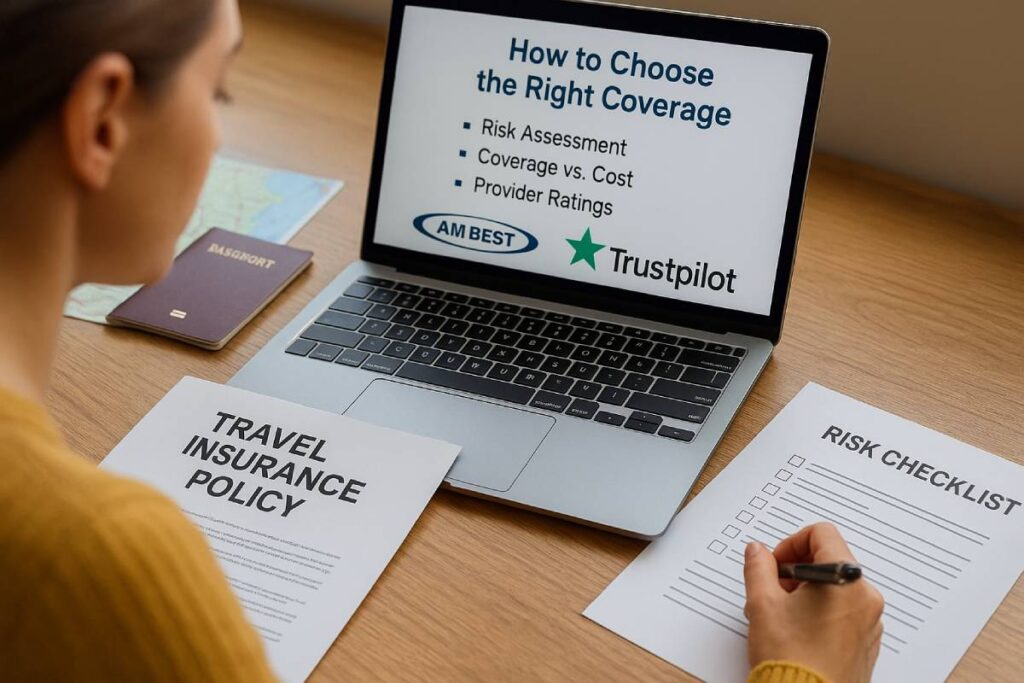Imagine planning your dream vacation only to be blindsided by a sudden medical bill overseas or a flight cancellation due to a hurricane.
With international trip costs soaring—averaging over $7,200 in 2025—protecting your investment is more crucial than ever.
Travel insurance stands guard against financial surprises, covering medical emergencies, trip interruptions, baggage mishaps, and more.
By understanding the coverages you truly need—from emergency evacuation to adventure-sports riders—you can tailor a policy that safeguards your peace of mind and wallet.
Let’s dive into the essential protections every global traveler should consider against unexpected costs.
Key Coverage Types

Travel insurance packages bundle several key coverages to protect you from unexpected medical bills, trip cancellations, lost luggage, emergency evacuations, pre-existing condition exclusions, and high-risk activity mishaps. Understanding each coverage type—its benefits, typical limits, and real-world applications—helps you tailor a policy that fits your trip profile and budget. Below is a detailed breakdown of the Key Coverage Types you’ll encounter when shopping for travel insurance.
Medical Expenses
Travel medical coverage reimburses emergency medical treatment, hospital stays, and often dental care abroad. According to Investopedia, “Medical coverage can help with unexpected international medical and dental expenses, and help with locating doctors and healthcare facilities abroad.”
Limits vary widely across plans—from $10,000 up to $2 million—depending on how comprehensive you need your policy to be. Squaremouth reports emergency medical limits in this range, with recommended minimums of $50,000.
Most policies include a medical deductible (typically $50–$250) and may impose 10–20% co-insurance after the deductible is met.
Trip Cancellation & Interruption
Trip Cancellation reimburses up to 100% of your prepaid, non-refundable trip costs if you cancel before departure for covered reasons like illness, jury duty, or severe weather.
Trip Interruption covers at least 100% of unused, prepaid expenses—and often 150–200% to pay for last-minute travel home and change fees—if you must cut your trip short.
Baggage Loss, Damage & Delay
Baggage Loss & Damage reimburses the actual cash value of items in lost, stolen, or damaged luggage. Typical limits range from $500 to $3,000 per traveler, with per-item caps of $50–$500 and total item-specific limits up to $1,000.
Baggage Delay benefits provide daily stipends—usually $100–$1,000 per person—when checked baggage is delayed more than 12–24 hours, to cover essentials like toiletries and clothes.
High-value items (e.g., jewelry, electronics) may require scheduled-item coverage or separate riders to be fully protected.
Emergency Evacuation & Repatriation
Emergency evacuation pays for transport—often via air ambulance—to the nearest adequate medical facility, and repatriation covers return-home costs when medically necessary. Travel insurance “covers the costs … injuries and evacuations” as part of its core benefits.
Because air ambulances can exceed $100,000, most policies start evacuation limits at $100,000, with many offering $200,000–$500,000 or more for remote or underserved destinations.
Pre-Existing Condition Waiver
A Pre-Existing Condition Waiver removes the exclusion for chronic or recently treated illnesses—provided you purchase your policy within the insurer’s specified window (typically 14–21 days after your first trip deposit).
Travel Guard notes that with the waiver in place, you simply seek medical care during travel and then submit your claim upon return, without extra steps to activate coverage for your condition.
Without this waiver, any condition treated or requiring medication within the 180-day look-back period is excluded.
Adventure Sports & High-Risk Activities
Standard travel insurance typically excludes extreme sports (e.g., scuba diving, bungee jumping, rock climbing), but you can add optional riders to cover these activities. U.S. News reports that leading adventure travel policies “include coverage for skydiving, scuba diving and rock climbing” along with sporting equipment rental reimbursement.
Always confirm any altitude limits, certification requirements, or extra medical screening that some insurers impose on high-risk activities.
Typical Coverage Limits at a Glance
| Coverage Type | Typical Coverage Amount | Notes |
|---|---|---|
| Medical Expenses | $10,000–$2,000,000 | Deductible $50–$250; co-insurance 0–20% |
| Trip Cancellation | Up to 100% of trip cost | Interruption often 150–200% for added travel home |
| Baggage Loss | $500–$3,000 per person | Per-item limits $50–$500; excludes high-value items unless scheduled |
| Baggage Delay | $100–$1,000 per delay event | Triggered after 12–24 hour delay; per-item caps may apply |
| Evacuation & Repatriation | $100,000+ | Essential for remote destinations; air ambulance costs can exceed $100,000 |
| Pre-Existing Condition Waiver | Waives exclusion | Must purchase within 14–21 days post deposit; 180-day look-back |
| Adventure Sports Rider | Varies by activity | Check policy definitions and activity-specific limits |
By knowing these core coverages—and their typical limits—you can confidently compare quotes, add necessary riders, and choose the right travel insurance policy for your next trip.
Special Traveler Profiles & Considerations
When tailoring travel insurance, it’s crucial to match your policy to the specific risks and lifestyle of different traveler types. Winter sports enthusiasts need sports-weather and gear coverage to protect against ski-lift accidents and equipment loss.
Those traveling during hurricane season should purchase protection at booking—most plans exclude named-storm cancellations if bought afterward—and verify whether coverage requires the storm to impact their exact destination. Digital nomads and long-term travelers benefit from plans that are renewable mid-trip, offer global medical benefits, and allow purchase from anywhere in the world.
Families often save on per-person premiums with a single group policy, though individual plans may better address diverse age and health needs within the household. Senior travelers face steep age-based premium surcharges—rates jump dramatically each decade after 50—and may encounter lowered medical limits unless they add elder-specific riders.
Budget-conscious travelers can secure core medical, cancellation, and baggage protection for as little as 4–6% of trip costs, and raising deductibles tends to reduce premiums by 30–50%.
Seasonal Travel
Winter Sports
Before hitting the slopes, confirm your plan includes sports-weather loss and equipment coverage to reimburse ski-lift accidents, medical bills, and gear replacement—policies often cap sports equipment loss at specific limits per item and per trip. Many winter sports policies also cover rental-equipment costs if your gear is delayed or damaged.
Hurricane Season
Purchase travel protection at the time of booking—if you wait until after a named storm forms, cancellations or interruptions caused by that storm are typically excluded. Even if your trip isn’t in the direct path, many plans require the storm to affect your specific destination (not just the general region) to trigger reimbursement.
Digital Nomads & Long-Term Travelers
Long-term travelers need flexible, renewable coverage:
- Renewable Mid-Trip: Plans like SafetyWing’s Nomad Insurance let you buy or extend coverage online from anywhere, covering extended stays up to one year and beyond.
- Global Medical Benefits: International health policies (e.g., IMG’s Patriot International Platinum) offer annual renewable medical limits up to $1 million, ideal for digital nomads on the move.
- Adventure Activity Coverage: Ensure your plan includes a pre-existing-condition waiver and adventure-sports rider to cover both remote work and weekend thrills.
Families vs. Individual Policies
- Family Plans: One policy covers all immediate family members—parents and kids—often reducing per-person premiums by 10–25% compared to separate policies.
- Individual Policies: Better for families with varied age profiles or unique medical needs; premiums are risk-rated per person, ensuring adequate coverage for each traveler’s profile.
- Group Insurance Dynamics: Group policies simplify administration but may offer uniform rates, whereas individual plans adjust costs to each member’s risk factors.
Senior Travelers
- Age-Based Premium Hikes: Insurance rates climb steeply each decade after age 50—travelers in their 60s can pay 20–30% more than those in their 40s, and rates often double by age 70.
- Coverage Limits: Some single-trip medical plans limit benefits for older age brackets (e.g., $50,000 max for travelers in their 70s; $10,000 for travelers over 80) unless a senior rider is added.
- Senior Riders: Optional add-ons can waive deductibles or boost medical limits for an extra premium—vital for travelers with chronic conditions or higher evacuation risks.
Budget-Conscious Travelers
- Core Coverage Only: Focus on medical, trip cancellation/interruption, and baggage protection, which combined cost roughly 4–6% of total prepaid trip expenses.
- Higher Deductibles: Opting for higher deductibles (e.g., $500–$1,000) can lower premiums by 30–50%, balancing out-of-pocket risk against cost savings.
- No-Frills Providers & Annual Plans: Consider basic plans or multi-trip annual policies to spread risk across several short journeys, often yielding lower per-trip costs. Premium variations will depend on plan structure and destination risk profiles.
By aligning policy features with your travel style—whether carving down black diamonds, navigating hurricane forecasts, living life unplugged as a nomad, journeying with family, enjoying golden-year getaways, or traveling on a budget—you’ll secure the right protection at the best price.
Credit Card Travel Insurance Limitations
Travel credit cards can offer valuable trip protections at no extra cost, but they come with important limitations. Most cards exclude pre-existing medical conditions and may only cover medical evacuation on a limited basis—even though air ambulances can exceed $30,000 in a single case. They also often exclude travel to high-risk destinations under government advisories. Crucially, benefits only activate if you charge your trip (or qualifying fees) to the specific card—simply having it in your wallet won’t help, and even paying just award-ticket taxes and fees “sometimes” counts.
Typical Exclusions
Pre-Existing Medical Conditions
Credit card travel insurance excludes treatment related to chronic or recently treated illnesses unless you meet a waiver’s strict criteria, such as purchasing within 14–21 days of your initial trip deposit.
Emergency Medical Evacuation
Many cards don’t cover non-medical evacuations and limit medical evacuation benefits. A helicopter medevac can cost over $30,000, yet most cards cap evacuation at $100,000 or exclude it entirely—only premium cards like Chase Sapphire Reserve or AmEx Platinum may cover it.
High-Risk Destinations
Cards often exclude travel to countries or regions under official advisories (war zones, terrorism risk, severe health outbreaks). Always check if your destination is on your card issuer’s exclusion list before relying on coverage.
Activation Requirement: Pay with the Specific Card
- Full or Partial Trip Payment
- You must charge trip expenses—flights, hotels, tours—to the card to unlock benefits.
- In some cases, paying only the taxes and fees on an award ticket may trigger coverage, but issuers vary (“sometimes”).
- No “Wallet-Only” Coverage
- Merely holding the card does not activate travel protections; always verify you used it for the booking.
Summary Table of Key Limitations
| Limitation | Details | Source |
|---|---|---|
| Pre-Existing Conditions | Excluded unless waived; look-back period often 180 days; waiver requires purchase within 14–21 days of deposit. | money.usnews |
| Medical Evacuation | Excluded or capped; air ambulance costs often > $30 000; only select premium cards cover fully. | thepointsguy |
| High-Risk Destinations | Excluded travel to areas under government advisories (war, terrorism, pandemics, etc.). | en.wikipedia.org |
| Activation Requirement | Must pay trip expenses with the specific card; simply holding it won’t unlock protections. | thepointsguy |
| Partial Payment Activation | Paying only award-ticket fees/taxes may count in some cases, but coverage is inconsistent across issuers (“sometimes”). | thepointsguy |
Takeaway: Credit card travel insurance can save money and hassle—but only when you understand its limits. Always review your card’s Guide to Benefits, confirm you’ve charged the trip correctly, and consider supplemental coverage for gaps like pre-existing conditions, full medical evacuation, or travel to high-risk regions.
Cost Factors Affecting Premiums
Travel insurance premiums typically range from 4% to 10% of your total prepaid, non-refundable trip cost, but can be as low as 4% or as high as 16% with certain providers. Premiums fluctuate based on five main factors: traveler age, trip cost, coverage limits, deductible amount, and optional riders like cancel-for-any-reason (CFAR).
Age of Traveler
Travelers’ ages heavily influence premiums because older travelers present higher medical risk. Seniors often pay more: Forbes finds that travelers over 60 may need to budget an additional 7% to 17% of their trip cost to cover senior travel insurance. Rates “go up dramatically for every decade over 50,” while children under 18 often enjoy free or very low-cost coverage.
Trip Cost
Insurers charge a percentage of your prepaid trip expenses—typically 4–10%—to calculate your premium. For example, a $5,000 trip usually costs between $200 and $500 to insure, aligning with the range NerdWallet observed (4–16% depending on provider and plan).
Coverage Limits
Higher coverage limits (e.g., increasing medical coverage from $50,000 to $500,000) directly raise premiums. WorldTrips notes that “as you increase your maximum coverage limit, expect your daily rate to increase,” since insurers charge more to underwrite greater risk.
Deductible Size
Choosing a higher deductible reduces your premium because you assume more initial cost before insurance pays. WorldTrips explains, “as you increase your deductible, your daily rate will likely decrease,” which can lower premiums by up to 20–30% depending on the amount.
Optional Riders (e.g., Cancel-For-Any-Reason)
Optional add-ons grant extra flexibility but at a price. MarketWatch reports that CFAR coverage usually costs about 50% more than standard policies, reflecting the broader cancellation rights it provides.
Premium Impact at a Glance
| Factor | Impact on Premium |
|---|---|
| Age (60+ years) | +7–17% of trip cost |
| Each decade over 50 | Dramatic spike; rates often double by ages 70+ |
| Trip Cost | 4–10% of total prepaid cost |
| Coverage Limits | Higher limits ↑ daily rate proportionally |
| Deductible Size | Higher deductible ↓ daily rate; up to 20–30% savings |
| Cancel-For-Any-Reason Rider | +50% over standard policy cost |
By understanding these factors, you can balance cost and protection:
- Younger travelers or those on smaller trips may opt for basic plans at the low end of the 4–6% range.
- Seniors or high-risk travelers should anticipate rates toward the upper end, and consider increasing medical limits or CFAR riders only if needed.
- Budget-minded travelers can manage cost by raising deductibles and foregoing optional riders, while still securing core medical and cancellation protection.
How to Choose the Right Coverage

Choosing the right travel insurance is all about aligning your policy with the unique risks of your trip, your budget, and the reliability of your insurer. Start by assessing risk—identify activities and destinations that require specific coverages. Then weigh coverage against cost, aiming for the sweet spot between necessary limits and affordable premiums. Next, vet providers by checking financial strength ratings and customer feedback. Finally, time your purchase to capture crucial waivers like for pre-existing conditions. This approach ensures you get the protection you actually need—without overpaying.
Risk Assessment
Match your itinerary’s activities and destinations to the right coverages:
- Identify high-risk activities (e.g., skiing, scuba diving, trekking) and confirm your plan either includes them or offers an optional rider. Adventure trips demand customizable policies to avoid denials for excluded sports.
- Evaluate destination-specific hazards, such as political instability or limited healthcare infrastructure, and ensure you have adequate medical and evacuation limits to respond to emergencies in remote regions.
- Use risk-rating tools or checklists to systematically map potential health and security threats—then select coverages that directly address the highest-impact risks on your trip.
Coverage vs. Cost
Strike the ideal balance between premium outlay and policy limits:
- Benchmark premium percentages: Single-trip insurance typically costs 4–10% of your total prepaid trip expenses; higher-risk or more comprehensive plans can push this toward 16%.
- Adjust deductibles: Increasing your deductible (e.g., from $100 to $500) can reduce premiums by up to 20–30%, but leaves you responsible for smaller claims.
- Select optional riders judiciously: Add-ons like Cancel-For-Any-Reason (CFAR) typically cost 40–60% more than base policies—only include them if you value that extra flexibility.
Provider Ratings
Ensure your insurer can pay claims reliably and treats customers fairly:
- AM Best Financial Strength Ratings: Look for ratings of A (Excellent) or higher to confirm the company’s claims-paying ability.
- Credit Rating Context: AM Best’s top rating is A++ (Superior), indicating strong financial health compared to peers.
- Customer Reviews: Consult The Points Guy’s roundup of Best Travel Insurance Providers and cross-check on Trustpilot or the Better Business Bureau for real-world claim experiences.
- U.S. News Ratings: U.S. News combines expert analysis with consumer surveys to rank the Best Travel Insurance Companies, offering a balanced view of reliability and value.
Timing for Pre-Existing Waiver
Lock in medical coverage for existing conditions by purchasing early:
- Purchase Window: Most plans require you to buy insurance within 14–21 days of your initial trip deposit to qualify for a Pre-Existing Condition Waiver.
- Lock-in Criteria: To trigger the waiver, you often must insure 100% of your prepaid, non-refundable trip costs at the time of purchase.
- Policy Variation: Check each insurer’s “look-back” period (commonly 60–180 days) and specific waiver deadlines—missing the window means any condition treated in that period will be excluded.
By following this four-step framework—assessing risk, balancing coverage and cost, vetting providers, and timing your purchase—you’ll confidently choose the travel insurance coverages that match your needs, protect your investment, and ensure peace of mind on every journey.
Step-by-Step Guide to Filing a Claim
Travel insurance claims hinge on four critical steps—documenting every detail, notifying your insurer quickly, submitting accurate forms with proof, and following up diligently. By mastering each phase, you’ll turn a daunting process into a seamless one, maximize your reimbursement, and avoid common pitfalls.
Document Everything
Begin building your case the moment an incident occurs. Insurers expect clear evidence, so collect:
- Receipts for out-of-pocket expenses (medical bills, emergency purchases, replacement costs)
- Police or carrier reports for theft, lost baggage, or accidents
- Medical records including treatment notes, prescriptions, and discharge summaries
- Correspondence such as emails or texts with airlines, hotels, or tour operators confirming delays or cancellations
Keep both digital and physical copies organized by date and claim type—this “story” of events speeds up review and reduces follow-up questions.
Notify Promptly
Most policies require you to alert your insurer—and, in some cases, your travel suppliers—within a tight window:
- Reporting timeframe: Typically 24–48 hours for emergencies like hospitalization, theft, or accidents
- Trip cancellations: Often within 72 hours of a covered event (e.g., illness, named storm)
- How to notify: Use your insurer’s 24/7 claims hotline, mobile app, or online portal—document the date, time, and any claim reference number you receive
Late notification can lead to denied or delayed claims, so set a reminder on your phone as soon as an incident happens.
Submit Forms & Proof
With your documentation in hand and your insurer notified, it’s time to file the actual claim:
- Access the correct form via your insurer’s website or app—don’t use generic templates
- Complete every field accurately: policy number, travel dates, incident description, and bank details for reimbursement
- Attach supporting documents in the requested formats (PDF, JPEG), ensuring they’re legible and organized by claim item
- Submit promptly—many insurers process online claims faster than mailed or emailed submissions
After submission, save a confirmation screenshot or email, along with any claim ID for reference.
Follow Up
Filing your claim is just the start—active follow-up keeps it moving:
- Check status weekly via the insurer’s portal or hotline; note any pending document requests
- Respond within 24 hours to requests for additional information to avoid processing delays
- Escalate if necessary: If you haven’t received an update in 14 days, politely ask for a supervisor or file a complaint with your state’s insurance department
- Document all interactions: Save emails, record call details (date, time, name of representative), and summarize key points in a shared folder
Proactive follow-up not only accelerates your reimbursement but also demonstrates diligence should you need to appeal a denial.
Timeline & Deadline Snapshot
| Step | Action | Recommended Deadline |
|---|---|---|
| Notify Insurer | Report incident via hotline/app/portal | Within 24–72 hours |
| Gather Documents | Collect receipts, reports, medical records | Immediately—within 1–3 days |
| Submit Claim | File online with forms & attachments | Within 7–90 days (per policy) |
| Follow Up | Check status; provide extra info if needed | Weekly until resolution |
By rigorously documenting your case, notifying promptly, submitting complete forms, and following up persistently, you’ll navigate the travel insurance claim process like a pro—turning potential headaches into smooth resolutions and ensuring you’re made whole after the unexpected.
Interactive Tools & Calls to Action
Travel insurance policies come with important exclusions and limitations that can leave you unprotected if you’re not aware of them. Known Events like pre-existing illnesses are typically excluded unless you secure a waiver, Uninsured Activities such as extreme sports require an additional rider, and High-Risk Destinations under government advisories often aren’t covered by standard plans. Moreover, insurers demand thorough Documentation—missing receipts, reports, or medical records can swiftly lead to claim denials. Understanding these pitfalls ensures you choose the right add-ons and gather the evidence needed to get your claim approved.
Coverage Exclusions & Limitations
Known Events (Pre-Existing Conditions)
Travel insurance almost universally excludes coverage for pre-existing medical conditions—that is, any illness, injury, or treatment that began before you purchased the policy. Insurers define a “pre-existing condition” by looking back typically 60–180 days before your policy’s effective date; without a waiver, any care or claims related to those conditions will be denied. To secure coverage, you must typically buy your policy within 14–21 days of your initial trip deposit and insure 100% of prepaid, non-refundable expenses.
Uninsured Activities (Extreme Sports)
Most base travel insurance plans exclude injuries from extreme or adventure sports, such as scuba diving, bungee jumping, or rock climbing, purely because of the heightened risk involved. Pacific Prime notes that standard policies only cover “non-extreme” activities unless you pay extra for an adventure sports rider, while InsureYonder reports these riders can boost coverage limits up to $250,000 for international trips—but at an increased premium. Always check your policy’s activity definitions and altitude or certification limits before booking any risky excursions.
High-Risk Destinations
Standard policies often exclude travel to destinations under government advisories—for example, war zones, active conflict areas, or regions with elevated terrorism or health risks. JoinYourTrip confirms that unless you purchase a specialized high-risk policy, incidents like evacuation or medical claims in such areas will not be covered. The U.S. State Department warns that medical evacuation benefits may not apply if you travel against official advisories, leaving you to shoulder exorbitant costs alone.
Documentation Requirements
Missing or incomplete documentation is a leading cause of claim denials. Allianz advises always providing itemized receipts, police or carrier reports, and medical records; failure to do so can result in immediate rejection. Insubuy and Share Lawyers emphasize that lost paperwork—from claim forms to proof of payment—accounts for a significant percentage of denied claims, and appeals often hinge on submitting the missing evidence. According to The Guardian, insurers may require claims to be filed within 30–90 days post-incident, and lacking photos or official statements can stall both initial and appeal processes.
Summary Table of Key Exclusions
| Exclusion Type | What’s Excluded | How to Mitigate |
|---|---|---|
| Known Events | Pre-existing illnesses, pre-trip conditions | Purchase within waiver window; insure full trip cost |
| Uninsured Activities | Extreme sports (scuba, bungee, climbing, etc.) | Add an adventure sports rider with defined coverage limits |
| High-Risk Destinations | War zones; areas under official travel advisories | Buy a specialized high-risk policy or avoid restricted regions |
| Documentation Requirements | Claims lacking receipts, reports, or medical records | Organize and submit all itemized bills, photos, and official reports |
By knowing these exclusions and limitations—and proactively securing waivers, riders, or specialized policies—you’ll ensure your travel insurance delivers the protection you truly need.
Conclusion
Travel insurance isn’t a one-size-fits-all product—it’s a customizable shield that adapts to your itinerary, age, and risk tolerance. By mapping your trip’s unique hazards—be it skiing in the Alps or sailing through hurricane season—you ensure essential coverages like medical, cancellation, and evacuation are in place.
Balancing coverage limits against your budget means adjusting deductibles or omitting add-ons you won’t use, while still capturing core protections at 4–10% of trip cost. Vet insurers via AM Best ratings and Trustpilot reviews to confirm they’ll honor claims promptly.
Finally, purchase within prescribed windows—especially for pre-existing condition waivers—to avoid gaps. With the right policy, you travel confidently, knowing unexpected events won’t derail your plans or deplete your savings.
Main Tips
- Purchase within 14–21 days of booking to lock in pre-existing condition waiver.
- Compare at least three insurers and check AM Best A-rated carriers.
- Raise deductibles to lower premiums—but keep them within your budget.
- Add CFAR only if you need ultimate cancellation flexibility.
- Review policy definitions for “covered reasons” and “named storms.”
FAQs
What does travel medical coverage include?
Emergency medical coverage reimburses hospital stays, doctor visits, and often dental care abroad, with limits ranging from $50,000 to $2 million.
When will trip cancellation coverage reimburse me?
Trip cancellation covers prepaid, non-refundable costs if you cancel before departure for covered reasons (illness, natural disasters), typically up to 100% of expenses.
How do I qualify for a pre-existing condition waiver?
Buy insurance within 14–21 days of your initial trip deposit, insuring 100% of non-refundable costs to waive look-back exclusions (usually 60–180 days).
Is adventure sports automatically covered?
No—standard plans exclude extreme activities like scuba or bungee jumping; add an adventure-sports rider to secure up to $250,000 in coverage.
Does baggage delay provide essentials reimbursement?
Yes—baggage delay benefits offer daily stipends ($100–$1,000) after 12–24 hours of delay for essentials like clothing and toiletries.





















